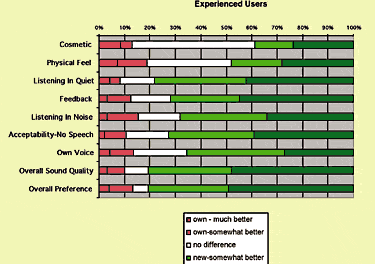January 10, 2007
LOS ANGELES — One in three adults aged 65 and older currently has a significant hearing loss, yet only 20% of them are using hearing aids, in part due to technical limitations and in part due to the fact that hearing aids are not considered appealing among baby boomers. The number of Americans aged 65 and older will more than double between now and 2030, increasing the number of people who will need treatment for hearing loss. House Ear Institute (HEI) researchers are anticipating this increase among those who will demand greater performance and cosmetic appeal in the devices that treat their hearing loss by developing two projects targeted for this group: The Hearing Aid Assessment Project and the NanoEAR.
The Hearing Aid Assessment Project (HAAP) is being developed now to survey both the needs of hearing aid users and current device technologies available. The HAAP research team is creating assessment tools and procedures to help patients and dispensing professionals better determine if the hearing aid technology they are considering meets their individual needs. The HAAP can help to ensure a patient doesn’t go home with a new hearing aid that later ends up in a drawer because it isn’t a good match.
The second project the Institute has in the pipeline points toward a higher-tech future for those with hearing loss. The NanoEAR is a prosthetic device that some day could eliminate hearing impairment through a combination of tissue engineering and nanotechnology. Because the hearing needs of each patient can never be completely met by aids that amplify sound, the goal of this effort is to develop a surgically implanted device designed to simulate the neuro-mechanical function of the inner ear (cochlea) and to make physiological connections from the device to the auditory nerve. The closest thing to this auditory device currently on the market is a cochlear implant, which performs the function that sensory cells within the cochlea would perform if they were working properly. However, the NanoEAR would be distinct from the cochlear implant in that it would perform the functions of the entire cochlea—its neuro-mechanics—rather than simulate the function of its sensory cells, reproducing near-normal frequency selectivity and sensitivity. The NanoEAR would also eliminate the need for batteries and visible external components. While none of the scientific or technological elements necessary to develop the NanoEAR is unique on its own, the integration of all the elements together into one prosthetic device that restores hearing is a novel objective.
"Achieving success through the merging of human tissue with artificial technology for the NanoEAR will require collaboration between many scientific disciplines, and each line of research involved in the development of this device could deliver information that is useful in other applications as well," says researcher Sigfrid Soli, PhD, of HEI. "While development of the NanoEAR is still years away, our goal is to develop the device when aging boomers and record numbers of people in need of new auditory technology will be at an all-time high."
The Hearing Aid Assessment Project (HAAP) has received support from the Daniels Fund and the Veneklasen Research Foundation. The Institute is seeking partnerships for the NanoEAR project through interested individuals, corporations, and foundations.
SOURCE: HEI




